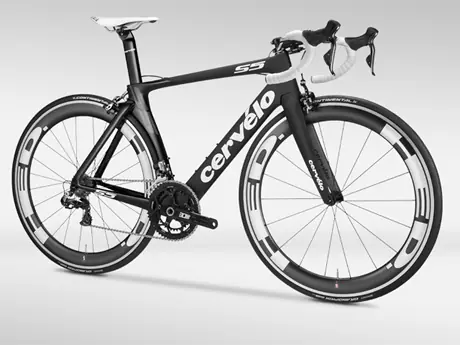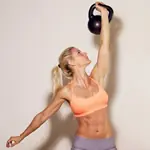
For Cervelo, anytime it launches an aero road bike (hell, any time it launches an aero anything), expectations are high. And that's as it should be; Cervelo was the brand that launched the category years ago with the Soloist, when then CSC rider Jacob Piil requested a road bike that was fast, but also aero. Guys like Piil and then CSC cohort Jens Voigt made it part of their arsenal for suicidal solo breakaways against the surging field. And just sometimes, the breakaway would succeed. And thusly, the aero road bike was born.
To date, the Cervelo S5 has become a common benchmark bike; while many bikes, like the BMC Time Machine TMR01, the Scott Foil Specialized's Venge, Ridley Noah and the Giant Propel have saturated the aero road bike segment, the S5 has come out on top in several tests, including TOUR magazine's independent aero test.
But Cervelo conceded that there was room for improvement in the S5, and decided a revamp was needed. And there were two overarching improvements Cervelo wanted to achieve with the rework of the S5. As an aero road bike, aerodynamic improvements were an obvious target. But so too was handling.
While the S5 was fast, it wasn't a superior, aggressive handler.
More: Review: Trek Speed Concept 9.9
"After the debut of the S5 a few years ago, as all engineers do right after the debut of a bike, look at it and said "aw, I wish we could've done this, or done that," said Heather Henderson, Cervelo senior product manager. "We were already the fastest aero road bike on the market, so since we led the category, we targeted ourselves."
After over 100 layup iterations (and six parsed out for prototyping), Cervelo settled on what will debut next year in the new 2014 S5. Cervelo's data shows it to be a faster bike than its previous best (Cervelo claims a 21.3-watt improvement over the previous S5 VWD). And that's all well and good. But what you feel of speed is in the ride; it's a more nimble, responsive, aggressive bike, something closer to the R5. With the 2014 update, the S5 became a markedly better race bike....certainly to those that will road race it, and likely, those that will drop the front end, load up some clip-on aerobars and take on a hilly triathlon with it.
To start, Cervelo employed what it has learned on its previous bikes—the R5 California, the S5 and R3—in the development of the new S5. Cervelo calls these trickle-down applications its core design features, and could be considered on their face "trickle-up" technology. New tooling/production advances that helped it tighten manufacturing tolerances, as well as improved carbon compaction techniques during production helped the frame lose weight by requiring less material overlap for structural purposes. It also added new features like a keyed seat binder and bosses for internal Shimano Di2 battery placement within the downtube that simply make a user and mechanic's life easier, and make for a cleaner presentation. Carbon dropouts, a dropped downtube, a low-friction bottom bracket cable guide, future-proof cable compatibility for electronic, mechanical or hydraulic, all part of the new S5 construct.
Further, the seattube takes on the look and feel of the P3 tri bike, which it borrowed from: a newly-shaped curved seattube, clearance for 25mm tires. It also borrow's the P3's new seatstay shoulder that, while filled in under the gap as it meets with the seattube, adds stiffness and shields the rear brake better aerodynamically. All learned from previous model builds, again, all built-in.
More: Review: SCOTT Foil 10
Aerodynamics
As one of the industry leaders in the aerodynamics research and application category, Cervelo had a tall ask in making an already fast bike faster. It took what it learned from bikes like the P5 and the new P3 in its improvements. Centrally, a downtube built aerodynamically for bottles (with a blunted trailing edge for better airflow around bottles), makes aero gains.
Photo by Jay Prasuhn
Wheel and tire clearance are now increased for today's wider rims and larger volume tires (the seattube gets 5mm wider) making a 25mm tire possible (which wasn't possible on the previous S5) fit into the seat tube cowling. That cowling now has a concave inner radius instead of the previous flat surface. The sum of changes adds up to the aforementioned 21.3-watt frameset improvement.
Aero Handlebar
It's the sum of small improvement through the frame that makes up that drag savings number. But the majority of it comes from a place you wouldn't normally consider: the handlebar.
Recently, Cervelo engineer Ivan Sidorovich broke the bike's aerodynamics down, piece by piece on CFD. Of course, the human on the bike was the biggest drag source. But with the rider percentage tared out (but with the rider figured into the airflow), the bike's aero drag broke down as follows:
Seatpost: 1 percent
Rear brake: 2 percent
Front brake: 3 percent
Rear Wheel: 5 percent
Drivetrain: 9 percent
Bottle: 9 percent
Fork: 9 percent
Frame: 16 percent
Front wheel: 16 percent
Handlebar: 30 percent
- 1
- of
- 4









Discuss This Article